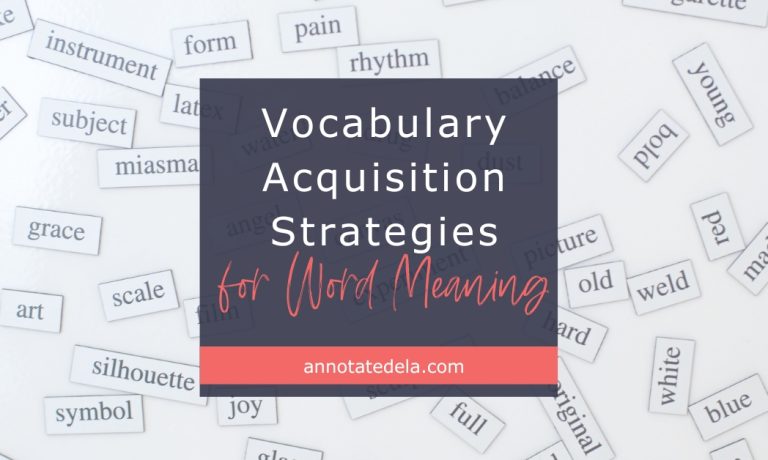Vocabulary acquisition strategies go beyond providing a list of words and defining them. As teachers, we want students to have word ownership. We want students to be word wizards because a verbal rich environment opens the doors to comprehension and critical thinking.
How do we encourage word ownership and develop an environment where students use the words they are learning?
Let’s dive into vocabulary acquisition strategies and how we can help students with word meaning after introducing words.
Frequent, Rich, and Extended Instruction
In the book, Bringing Words to Life: Robust Vocabulary Instruction by Isabel L. Beck, Margaret G. McKeown, and Linda Kucan vocabulary acquisition strategies should be designed around three features:
- Frequent encounters with the word
- Richness of instruction
- Extension of word use beyond the classroom
Frequency
Introduce 5-10 words per week (or any amount that works for you and your students). Create activities to interact with the words daily throughout the week so that students focus on the vocabulary 8-10 times.
Richness
Rich vocabulary instruction goes beyond memorizing definitions and gets students involved in using and thinking about the words. Meaning is flexible and words have many shades of meaning; students need to have opportunities to encounter words in a variety of contexts and not just memorize definitions.
Provide students with opportunities to use the words, explore facets of word meaning, and consider relationships among the words.
Students’ Use of Words
Have students create uses for words so they can build a context around the words. Without ideas of how the word can be used or when the word might be used, the word becomes a piece of isolated information.
Facets of Word Meaning
Students should have a flexible understanding of the words so they can both understand the words and apply the word in a variety of contexts.
One activity is to have students differentiate between what a word is and what a word is not (example and nonexample) to expose students to facets of meaning.

Relationships among words
Creating activities that help students make connections between words encourages a broad view of meaning and moving beyond narrow associations. The more connections a student can make between words, the more likely the student will get to the knowledge. Students become more likely to derive meaning from words in context as they continue to make connections.
Alternative definitions and time constraints
Providing alternate meanings for words means students are not memorizing definitions, but are thinking about the word in multiple and meaningful ways.
Adding a time constraint to the processing of the words ‘trains’ students to process the meaning and the word quickly so that when they see it in print they are able to quickly access meaning.
Providing multiple meanings helps students make meaning and connections.

Adding a time constraint to a vocabulary activity helps students process words quickly as they encounter the words in print. Setting a timer and provisioning questions, like the example below, is one way to gamify the learning.

Extension – Beyond the Classroom
Students need to take their learning outside of the classroom or they begin to think that the learning and the words are only part of the classroom.
Results of Frequent, Rich, and Extended Instruction
Students who receive this type of instruction perform better than students who merely memorize definitions.
These students demonstrate better comprehension, deeper understanding of the meanings of words when presented in context, use words easily and appropriately, and also begin to take notice of new words.
Upper Elementary Vocabulary Acquisition Strategies
Introducing words around a theme or topic of study creates ready-made connections for elementary students and provides deeper meaning of the words.
A general rule for working with words is to work with them on a five-day cycle. But depending on the goal of the vocabulary instruction, it may be less than five days or more than five days
What is important is to introduce the word(s), spend at least two days working with the words so there is a follow-up to the introduction, and perform some sort of assessment.
Multiple-choice tests can be an easy way to assess students learning, but consider the following when assessing vocabulary acquisition.

Middle and High School Vocabulary Acquisition Strategies
Middle and high school students should explore language on a deeper level because the words and language become more complex and sophisticated.
Building language knowledge comes from students understanding both similarities and differences among words. Simply introducing or identifying a synonym for a word is not enough.
Vocabulary work in middle and high school can also be rooted to a text that not only teaches the meaning of the word, but also provides a rich understanding of the text.
The flow of vocabulary acquisition strategies could go something along the lines of:
Record the Words
Students should keep a record of words learned in a notebook or journal. The entries should include the word, the definition, an example of how the word can be used, and later an activity that asks students to provide examples of the word.
Facets of Word Meanings
Use the context of the text that is being studied as a foundation for discussing the vocabulary words. Talking about the story can prompt students to think about the word(s) and elaborate on meanings while also helping students make connections to other words and concepts they know as they relate to the story.
Relationships Among Words
Students should consider how word meanings interact. Understanding the relationship among words helps students make meaning in various contexts and creates a rich verbal environment where students own the words they are learning.
Students’ Use of Words
Provide opportunities for students to use the words is essential. Have students work in groups or pairs to write sentences using the words and then share them so the class can discuss the words and how they are used. The discussion around the sentences is the most vital part of the vocabulary acquisition strategy.
Beyond the Classroom
Assign activities that encourage students to find the words “in the wild” will cement meaning and help students understand that words exist outside of the classroom.
Assessment
What does it mean to know a word?
Establish the learning goal before the assessment. For example, a student may be able to identify a synonym for the word, but not be able to use it in context. What is the goal?
Although multiple-choice assessments have their place they can make it easy to get a correct answer without deep knowledge, or it can make it difficult because the incorrect answers are confusing.
The key is to remember that word knowledge is a continuum and the assessment that follows should measure the learning goal.
A variety of tasks can assess understanding on a deeper level.

Vocabulary work should be continuous by providing activities and opportunities to use the words in context and use the words outside of the classroom.
Words are complex and learned through multiple exposures in a variety of contexts.
As students get older, words become more complex because the words are sophisticated and multidimensional in their meanings. Vocabulary acquisition strategies help students uncover the layers of meaning.




4 Responses